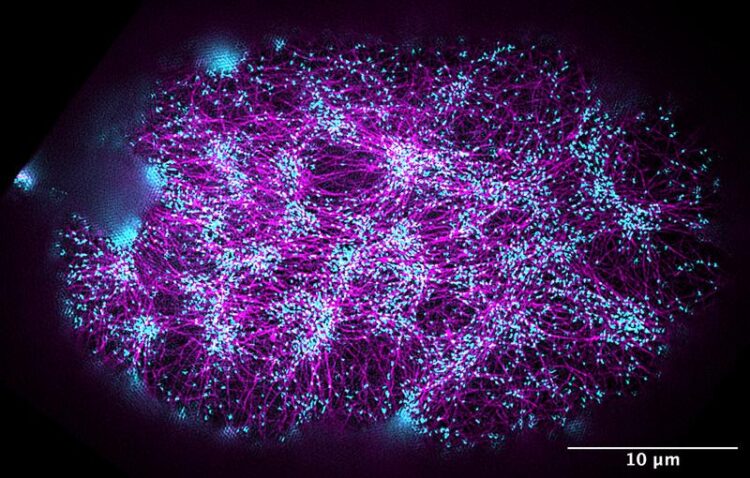Rotating forces get embryos in shape

Bild des Aktomyosin-Kortex in einem einzelligen Embryo, aufgenommen mit hochauflösender Fluoreszenzmikroskopie. Die Aktinfilamente sind magentafarben markiert, die Bereiche, in denen Kräfte und Drehmomente erzeugt werden, sind cyanfarben markiert.
Sylvia Hurlimann / Middelkoop et al. PNAS, 18. Mai 2021 / MPI-CBG
Dresden researchers discover how a protein creates the rotatory forces essential for animal development.
Our body appearance is symmetric from the outside. If you take a look inside, you will find our organs are not at all arranged symmetrically. The heart, for example, is on our left side. These differences in structure, referred to as left-right asymmetry, emerge very early during the development and are crucial for an embryo to properly grow. Researchers have found in past studies that rotatory forces, so-called torques, play an important role to create the left-right asymmetry, thereby shaping cells and organs. Now, scientists from the Max Planck Institute of Molecular Cell Biology and Genetics (MPI-CBG), the Biotechnology Center of the TU Dresden (BIOTEC), and the Cluster of Excellence Physics of Life (PoL) at the TU Dresden identified the proteins involved in the generation of torques and explained their interaction.
A developing organism needs axes for orientation: Where is the top and the lower part of the body, where the back and the front? A third axis defines where the left and the right side goes. While the outside of our body is overall left-right symmetric, our internal organs are arranged left-right asymmetrically. This left-right asymmetry arises already during the early development of an embryo, and can even be observed within individual embryonic cells. Cellular left-right symmetry breaking depends on the cell cortex – a fine network of actin filaments and myosin motor proteins just below the cell membrane.
In response to Myosin motor activity, the cortex undergoes cellular-scale movements, or flows, and sets itself in motion in a collective manner. Interestingly, the cortex undergoes a rotational movement: the opposite halves of embryonic cells rotate in opposite directions. In turn, these opposite rotations cause the tilting of some cells, and thus lead to the breaking of the left-right symmetry of the entire organism. This mechanism was identified in past studies by the research lab of Stephan Grill, who is a director at the MPI-CBG and speaker of PoL.
From physics we know that rotatory movements arise in response to rotatory forces or torques. What was not known so far, is which molecules are responsible for actively generating the rotatory forces that facilitate counter-rotations, and how they do this? The postdoctoral researcher Teije Middelkoop in the group of Stephan Grill worked together with researchers from the California Institute of Technology (Caltech), USA and the Massachusetts Institute of Technology (MIT), USA to address this question. Teije Middelkoop suspected that two groups of proteins are involved in creating torques: Formin proteins that help to generate actin filaments and Myosin motor proteins that pull on actin filaments.
Because actin filaments are molecular cables with a right-handed helical twist, both these proteins could in principle generate molecular scale rotatory forces, but whether and how these two protein types interact was unclear. Teije Middelkoop explains: “By performing fluorescent confocal microscopy, we found that counter-rotating flows in the cortex of the Caenorhabditis elegans roundworm increased when there was more Formin available. Once we reduced the amount of Formin in the roundworm or removed it completely, we also saw less torques in the cortex.”
Moreover, the researchers found out how Myosin and Formin cooperate: While Myosin is required to trigger the necessary cortical movements, analogous to the engine of a car, Formin acts like a steering wheel and ensures that the forces generated by myosin cause rotating flows and cell movements.
Stephan Grill summarizes: “These findings are another example of bridging physics and biology that has long been done in an ideal way here in Dresden. We have biologists and theoretical physicists on campus who are able to provide an interdisciplinary approach to the physics of biological processes. And the exciting thing about this study is that we now understand the physical forces and torques underlying embryonic growth a bit better.”
Wissenschaftliche Ansprechpartner:
Prof. Stephan Grill
grill@mpi-cbg.de
Originalpublikation:
Teije C. Middelkoop, Júlia Garcia-Baucells, Porfirio Quintero-Cadena, Lokesh G. Pimpale, Shahrzad Yazdi, Paul W. Sternberg, Peter Gross, and Stephan W. Grill: CYK-1/Formin activation in cortical RhoA signaling centers promotes organismal left–right symmetry breaking. PNAS 18. May 2021, Doi: 10.1073/pnas.2021814118
Media Contact
All latest news from the category: Life Sciences and Chemistry
Articles and reports from the Life Sciences and chemistry area deal with applied and basic research into modern biology, chemistry and human medicine.
Valuable information can be found on a range of life sciences fields including bacteriology, biochemistry, bionics, bioinformatics, biophysics, biotechnology, genetics, geobotany, human biology, marine biology, microbiology, molecular biology, cellular biology, zoology, bioinorganic chemistry, microchemistry and environmental chemistry.
Newest articles

Innovative 3D printed scaffolds offer new hope for bone healing
Researchers at the Institute for Bioengineering of Catalonia have developed novel 3D printed PLA-CaP scaffolds that promote blood vessel formation, ensuring better healing and regeneration of bone tissue. Bone is…

The surprising role of gut infection in Alzheimer’s disease
ASU- and Banner Alzheimer’s Institute-led study implicates link between a common virus and the disease, which travels from the gut to the brain and may be a target for antiviral…

Molecular gardening: New enzymes discovered for protein modification pruning
How deubiquitinases USP53 and USP54 cleave long polyubiquitin chains and how the former is linked to liver disease in children. Deubiquitinases (DUBs) are enzymes used by cells to trim protein…



